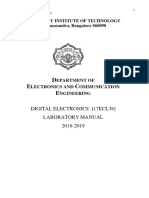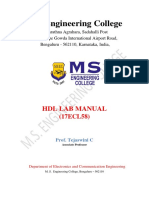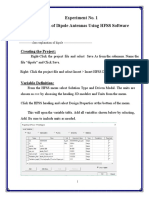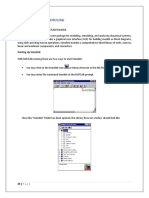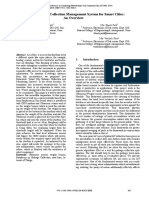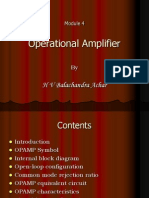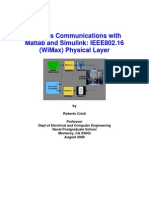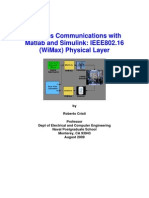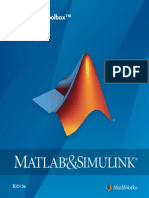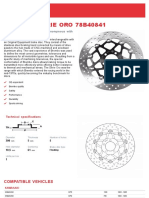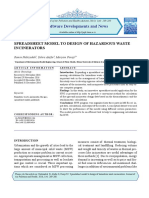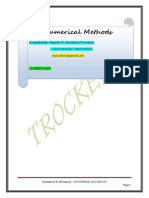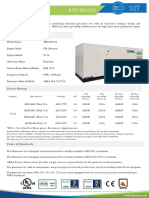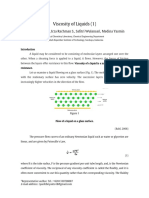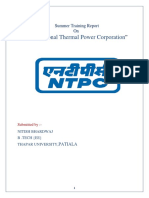MATLAB and Simulink for Engineering Education
2009 The MathWorks, Inc.
Tabrez Khan Applications Engineer MathWorks India Pvt. Ltd tabrez.khan@mathworks.in
Agenda
Filter Design & Analysis Fixed Point Analysis Neural Network Design and Analysis Lunch Break Signal Processing, Communications and Video System Design Event-Driven and Discrete Event Simulation Implementation and Verification on Embedded Targets
Objective
Filter Design and Analysis
What is fixed point?
Binary representation of data with finite number of bits Finite word length arithmetic with a fixed number of fractional digits Optimal for machine, hard for humans to program
Sign bit
If signed
1st integer bit
Binary point
Number of fractional bits (3) Word length (8)
4
Who is interested in fixed-point design?
People whose everyday tasks involve:
Designing, analyzing, and verifying fixed-point algorithms FPGA or ASIC Fixed-point DSP chip Microcontrollers
Designers whose hardware targets include:
Fixed-Point Data Types in MATLAB
Features fixed-point numeric object fi
Bit-true, fixed-point math in MATLAB Fixed-point algorithm development in M Natural MATLAB syntax
>> a=fi(pi, true, 8, 5); >> bin(a) 0 1 0 1 0 1 1 . 0 s 2 1 . 1/2 1/4 1/8 1/16 1/32 >> double(a) 3.15625
6
Parts of a fi Object
>> a = fi(pi) a = 3.1416015625 DataTypeMode: Signed: WordLength: FractionLength: RoundMode: OverflowMode: ProductMode: MaxProductWordLength: SumMode: MaxSumWordLength: CastBeforeSum: Fixed-point: binary point scaling true 16 13 nearest saturate FullPrecision 128 FullPrecision 128 true
data
numerictype
fimath
Streamlined Floating-to-Fixed Conversion
Turn on logging mode Set data type override parameters Observe dynamic range of variables in your M-code Set the best fixed-point attributes to avoid overflow or underflow and large quantization errors
Introduction
Neural Networks
The network is adjusted, based on a comparison of the output and the target, until the network output matches the target.
Target
Neural Network including connections (called weights) between neurons
Input
Output
Compare
Adjust weights
9
Neural Networks applications
Biotech
Cancer detection, Gene expression analysis, EEG and ECG analysis, Data Mining Market forecasting, Credit evaluation, Fraud detection, Real estate appraisal, Mortgage screening, Corporate bond rating, Portfolio trading program, Corporate financial analysis, Currency price prediction OCR, Handwriting recognition, Biometrics, Image and data compression, Fault detection and compensation, Nonlinear adaptive control, Process control, Robotics
Financial Services
Other
10
Common Pain
Technology is complex and difficult to understand Steep Learning curve associated with learning and applying neural networks Solution : Mathworks offers Neural Networks Toolbox that allows users to use proven and tested built-in training algorithms and graphical tools thereby substantially reducing the effort and time needed to design, implement, evaluate, visualize and simulate neural networks.
11
Design of Neural Networks
Basically comprises of following three steps: Initialization >> net=newff([0 2],[20 1],{tansig, purelin}, trainlm); Training >> net=train(net,P,T) Simulation >> a=sim(net,P)
Conversion to Simulink Block
Simulink model from trained network can be generated using the gensim(net) command
12
Sampling Signals
Analog signal sources
Electromagnetic, audio, sonar, biomedical
Sampling
x( n) = xa (nTs )
discrete signal analog signal sample time
2009 The MathWorks, Inc.
13
Aliasing
Shannon Sampling Theorem:
fs > 2 fM
fs > 2 fM
fs 2 fM
Original signal and sampled signal have same frequency
Sampled signal is aliased to half the original frequency
2009 The MathWorks, Inc.
14
Signal Generation
Signals Create a time-base vector
>> t = [0:0.1:2];
Signal as function of time
>> x = sin(pi*t/2);
Useful MATLAB Functions Nonperiodic functions
ones, zeros
Periodic functions
sin, cos, square, sawtooth
2009 The MathWorks, Inc.
15
Amplitude Modulation
Amplitude Modulation is a process where the amplitude of a carrier signal is altered according to information in a message signal. The frequency of the carrier signal is usually much greater than the highest frequency of the input message signal.
16
AM Basic Definitions
The AM signal
5
s (t ) = Ac [1 + k m(t )]cos ct
The modulating signal:
-5 0 01 02 03 04 05 06 07 08 09 0 .0 .0 .0 .0 .0 .0 .0 .0 .0 .1 1
m(t )
The Carrier Signal:
-1 0 01 02 03 04 05 06 07 08 09 0 .0 .0 .0 .0 .0 .0 .0 .0 .0 .1 1
c(t ) = Ac cos c t
-1 0 01 02 03 04 05 06 07 08 09 0 .0 .0 .0 .0 .0 .0 .0 .0 .0 .1
17
Wireless Communication System Design
Physical layer design
Digital baseband design: Channel coding, modulation, spreading and filtering RF/Analog: Non-linearity, phase noise and noise figure Receiver algorithms: Carrier recovery, timing recovery, equalization Acknowledgement schemes, call processing, and simple protocols
MAC/Data link layer design
18
Collect Blocks and Set Parameters
QPSK Transmitter QPSK Receiver
1. Drag and Drop Library Blocks into Simulink Model 2. Double Click on Blocks to Edit Block Parameters
19
Run Simulation and Visualize Results
Start Simulation
Visualize Output
20
Construct Receiver and Examine Received Bits
QPSK Transmitter QPSK Receiver
Error Rate Error Bits Received Bitsc
Received Signal
21
Example: IEEE 802.11a System
22
Stateflow Overview
Extend Simulink with a design environment for developing state machines and flow charts Design systems containing control, supervisory, and mode logic Describe logic in a natural and understandable form with deterministic execution semantic
23
Modeling Performance of Transport and Networks Layers
SimEvents extends Simulink with discrete-event simulation Efficient, event-driven modeling of data packets passing through network of queues, servers, gates, and switches Connects to lower layers modeled in Simulink and Stateflow
24
Communications protocol stack
Example Open Systems Interconnection OSI model from International Standards Organization (ISO)
7. Application
e.g. web browser
7. Application
UML: Transactional modeling languages Large scale applications programming
6. Presentation
e.g. Windows
6. Presentation
5. Session
e.g. NT login
5. Session
SimEvents: Discrete event
4. Transport
e.g. TCP
4. Transport
3. Network
e.g. IP
3. Network
Stateflow: State transition Comms Blockset: coding, modulation, etc. Signal Proc Blockset: Sampled data processing Simulink: Time domain
2. Data Link and Medium Access Control
e.g. WiFi MAC
2. Data Link and Medium Access Control
1. Physical
e.g. WiFi PHY
1. Physical
"0". RF or "analog front end" components and medium (the aether, copper or fiber) with impairments caused by both
Seven specialist layers in a protocol stack: Divide and conquer
25
25
Some Image Processing Applications
Automotive Defense Biometrics Medical Diagnosis
Earth Sciences
Microscopy
Semiconductors
Drug Discovery
26
Objective: Noise Filtering in the Video Stream Construct your model
through an intuitive block diagram Use Simulink Blocks to build your algorithm and model your system
View signals from block to block to determine the effectiveness of your model
27
Objective: To Build Sobel Algorithm for Edge Detection
Input Image
Edges
2D Filter
(.)2
SQRT and Thresholding
2D Filter
(.)2
28
The System Design Challenge
We design, simulate, and validate system models and algorithms in MATLAB and/or Simulink How can we implement and verify designs on DSPs and GPPs? How can we implement and verify designs on FPGAs and ASICs?
C HDL
MATLAB and Simulink Algorithm and System Design
MCU
DSP
FPGA
ASIC
29
Embedded Software Design: TI Processors
Algorithm Development
Target Support Package TC2
System Design
MATLAB
Simulink
Real-Time Workshop Target Support Packages C/ASM Code
Stateflow
Real-Time Workshop Embedded Coder Target Support Package TC6
DSP Hardware
Embedded IDE Link CC
Compile & Link
Texas Instruments Code Composer Studio Environment Debug
Down load
C2000 DSP C5000 DSP C6000 DSP
30
Model-Based Design Flow for Hardware Implementation
Requirements
Algorithmic Development
System Design and Simulation
Simulink Stateflow Embedded MATLAB
EDA Simulator Link
Simulink HDL Coder
Filter Design HDL Coder
Xilinx ISE Synplify Pro PrecisionRTL Altera Quartus II DesignCompiler
/ External Code VHDL,
Generic RTL VHDL / Verilog Digital Embedded Legacy Electronics Software Verilog C, HDL Simulation C++
Mentor Graphics ModelSim
Cadence Incisive Synopsys Discovery
FPGA
ASIC MCU Synthesis P&R
Integration
DSP
Test Environments
Leonardo FPGA ASIC
Continuous V&V 31
Implement Implement
MathWorks India Contact Details
E-mail: info@mathworks.in Technical Support E-mail: support@mathworks.in URL: http://www.mathworks.in Address / Tel/ Fax: MathWorks India Private Limited Salarpuria Windsor Building Third Floor, 'A' Wing No.3 Ulsoor Road Bangalore - 560042, Karnataka India Tel: +91 - 80 - 6632 6000 Fax: +91- 80 - 6632 6010
Thank You!
32

